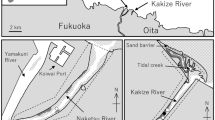Synopsis
Fish communities of major river systems in South America contain a high proportion of detritivorous fishes in the families Prochilodontidae and Curimatidae. These families include important fish stocks that in some regions comprise over 50 percent of the community ichthyomass. As a group, detritivores have anatomical-physiological adaptations for collection and digestion of detritus, but the actual mechanisms of these presumed adaptations have to-date only been inferred. Dietary requirements have not been identified. Behavioral adaptation is implied by feeding habitat selection but its nutritional significance is unknown. Because many of these species have commercial importance, and because ongoing construction of impoundments threatens to disrupt seasonal migrations between spawning and feeding areas, an understanding of the feeding biology of detritivores is important.
Similar content being viewed by others
References cited
Angelescu, V. & F.S. Gneri. 1949. Adaptations of the alimentary canal in some species of the Uruguay river and La Plata river. I. Omnivores and iliovores in the families Loricariidae and Anostomidae. Rev. Inst. Nac. Cien. Nat. Cien. Zool. 1: 161–172. (In Spanish.)
Bakare, O. 1970. Bottom deposits as food of inland freshwater fish. pp. 65–85.In: S.A. Visser (ed.) Kainji Lake Studies, Univ. Press, Ibadan, Nigeria.
Bayley, P.B. 1973. Studies on the migratory characin,Prochilodus platensis Homberg 1889 (Pisces, Characoidei) in the River Pilcomayo, South America. J. Fish Biol. 5: 25–40.
Bonetto, A.A. 1970. Principal limnological features of northeastern Argentina. Soc. Arg. Bot. Supplement 11: 185–209. (In Spanish.)
Bonetto, A.A., W. Dioni & C. Pignalberi. 1969. Limnological investigations on biotic communities in the middle Paraná River Valley. Verh. intern. Verein. Limnol. 17: 1035–1050.
Bowen, S.H. 1976. Mechanisms for digestion of detrital bacteria by the cichlid fishSarotherodon mossambicus (Peters). Nature 260: 137–138.
Bowen, S.H. 1979a. A nutritional constraint in detritivory by fishes: The stunted populations ofSarotherodon mossambicus in Lake Sibaya, South Africa. Ecolog. Monogr. 49: 17–31.
Bowen, S.H. 1979b. Determinants of the chemical composition of periphytic detrital aggregate in a tropical lake (Lake Valencia, Venezuela). Archiv Hydrobiol. 87: 166–177.
Bowen, S.H. 1980. Detrital nonprotein amino acids are the key to rapid growth ofTilapia in Lake Valencia, Venezuela. Science 207: 1216–1218.
Bowen, S.H. 1981. Digestion and assimilation of periphytic detrital aggregate byTilapia mossambicus. Trans. Amer. Fish. Soc. 110: 241–247.
Bowen, S.H. 1982a. Feeding, digestion and growth-qualitative considerations. pp. 141–156.In: R.S.V. Pullin & R.H. Lowe-McConnell (ed.), The Biology and Culture of Tilapias, IC-LARM Conf. Proc. 7, Manila.
Bowen, S.H. 1982b. Detritivory and herbivory.In: C. Leveque et al. (ed.) Biology and Ecology of African Freshwater Fishes (in press).
Caulton, M.S. 1976. The importance of pre-digestive food preparation toTilapia rendalli when feeding on aquatic macrophytes. Trans. Rhod. Scien. Ass. 57: 22–28.
Eggers, D.M., N.W. Bartoo, N.A. Richard, R.E. Nelson, R.C. Wissmar, R.L. Burner & A.H. Devol. 1978. The Lake Washington ecosystem: The perspective from the fish community production forage base. J. Fish. Res. Board Can. 35: 1553–1571.
Fryer, G. & T.D. Iles. 1972. The cichlid fishes of the great lakes of Africa. Oliver and Boyd, Edinburg. 641 pp.
Goulding, M. 1981. Man and fisheries on an Amazon frontier. Developments in Hydrobiology 4, Dr W. Junk Publishers, The Hague, 137 pp.
Kapoor, B.G., H. Smit & I.A. Verighina. 1975. The alimentary canal and digestion in teleosts. Adv. in Mar. Biol. 13: 109–300.
Lowe-McConnell, R.H. 1975. Fish communities in tropical freshwaters. Longman, New York, 337 pp.
Mago, F.M.L. 1972. Considerations in the systematics of the family Prochilodontidae with a synopsis of the Venezuelan species. Acta Biol. Venez. 8: 35–96. (In Spanish.)
Mann, K.H. 1972. Introductory remarks. pp. 13–16.In: Melchiorri-Santolini & J.W. Hopton (ed.) Detritus and its Role in Aquatic Ecosystems, Mem. Inst. Ital. Idrobiol. 29 (suppl.).
Moriarty, D.J.W. 1973. The physiology of digestion of bluegreen algae in the cichlid fish,Tilapia nilotica. J. Zool. 171: 25–39.
Nelson, J.S. 1976. Fishes of the world. John Wiley and Sons, New York. 416 pp.
Odum, W.E. 1968. The ecological significance of fine particle selection by striped mulletMugil cephalus. Limnol. Oceanogr. 13: 92–98.
Odum, W.E. 1970. Utilization of the direct grazing and plant detritus food chains by the striped mulletMugil cephalus. pp. 222–240. In: J.H. Steele (ed.) Marine Food Chains, University of California Press, Berkeley.
Payne, A.I. 1978. Gut pH and digestive strategies in estuarine grey mullet (Mugilidae) and tilapia (Cichlidae). J. Fish Biol. 13: 627–630.
Pearse, A.S. 1920. The fishes of Lake Valencia, Venezuela. University of Wisconsin Studies in Science 1, Madison.
Author information
Authors and Affiliations
Rights and permissions
About this article
Cite this article
Bowen, S.H. Detritivory in neotropical fish communities. Environ Biol Fish 9, 137–144 (1983). https://doi.org/10.1007/BF00690858
Received:
Accepted:
Issue Date:
DOI: https://doi.org/10.1007/BF00690858




